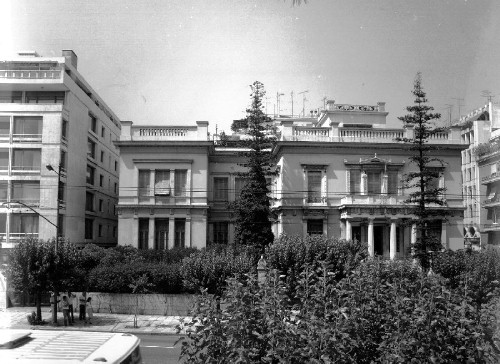|
|
The New Benaki Museum |

In the sixty years that have passed since the museum's foundation, it is not only the initial quantity of its material and the number of staff and of visitors that have altered or the motive forces in the initial trends of the continuously expanding social services it performs, but also the theories that today underpin the existence of other similar institutions. Hence it was determined to decentralise the integral cultural groups represented in the museum collections and to give autonomy to certain departments that had meanwhile enlarged their scientific activity.
The concept behind the organisational plan rests upon the principles of a satellite system.
The epi-centre of the system will continue to be the historic neo-classical mansion of the Benaki Museum which has already been modernised and to which has been added a new wing erected on the open space at the back of the site. The effective area of the Museum has been doubled and now amounts to 7000 sq.m.: a) two storage basements, the Library, Administration, Documentation Department and the offices of various scientific departments, b) the terrace with the refreshment room and a small auditorium equipped with an electronic multimedia facility and a large independent multi-purpose room suitable for holding a variety of events, c) the Greek collections deployed throughout the rest of the building in such a way that they present a complete picture of the continuum of Greek history, giving a general sense of its unbroken coherence reflected in the endurance of the language and in the resourceful adaptations of its artistic intuition.
The large and already autonomous group of the Islamic arts collections was decentralised. An independent museum annexe on Dipylou and Asomaton Streets, Athens, has been chosen as more suitable for their display. The creation of an independent unit dedicated to the study of Islamic civilisation can be held from every point of view to be a pioneering step, even judged at an international level.
The new spirit imbuing the organisation, especially the freedom it allows for possible further growth, was demonstrated by the invaluable gift of the artist Nikos Hadjikyriakos-Ghikas: an entire apartment block situated on Kriezotou Street in the centre of Athens. It includes his own home, his library and private collections, his studio and a floor dedicated to his work, and is already functioning as an independent annexe of the Benaki Museum.
Here the Chinese ceramics collection will strongly be on display, reflecting the artist’s particular cultural affinity with the Far Eastern world, an affinity apparent in many of his works.
The various sections of the Conservation Department will be housed in the same building, giving them elbow room and space into which to expand.
Since 1994 the Historical Archives Department with its staff and vast quantity of material has been re-housed in Kiphissia in the mansion that belonged to Penelope Delta.
Similarly, the Photographic Archive, with its precious material and a new service for the conservation of old photographs, will be moving as soon as the necessary alterations have been completed to a property on Kolonaki Square, Athens.
The Documentation Centre for neo-Hellenic Architecture, constantly being enriched with new material, will move to a property on Isiodou Street, Athens.
The collection of children’s Toys and Games will draw breath again in the fairy tale neo-Gothic mansion in Palaio Phaliro, a seaside suburb of Athens.
© 1998 Oxfordshire Museum Service, Setúbal Museums and the Benaki Museum